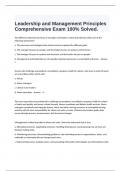Leadership and Management Principles
Comprehensive Exam 100% Solved.
The difference between the focus of managers and leaders is best described by which one of the
following statements?
a. The processes and strategies look similar and are employed for different goals.
b. The manager focuses on people, and the leader focuses on systems and structure.
c. The manager focuses on systems and structure, and the leader focuses on people.
d. Management and leadership are not equally important processes to accomplish outcomes. - Answer
c.
Nurses who challenge assumptions, consolidate a purpose, build the culture, and move a vision forward
are more likely within which role?
a. Nurses
b. Nurse managers
c. Clinical nurse leaders
d. Nurse executives - Answer d.
The nurse executives are positioned to challenge assumptions, consolidate a purpose, build the culture
of safety and quality, and move a vision forward. Nurses coordinate and deliver health services. Nurse
managers coordinate and integrate human, fiscal, and other nursing resources to accomplish nursing
practice with 24-hour accountability for client care units or areas. Clinical nurse leaders guide other
nurses through process, measurement, and document changes.
Management is often described in three core roles. Select the statement that is true.
a. Allocating resources, negotiating contracts, handling disturbances, and proposing new services are
decision-making roles.
b. Monitoring processes, disseminating guidelines, and motivating nurses in organizations, states, and
nationally or internationally are interpersonal roles.
c. Representing nurses, leading nurses, and associating information technologies are informational roles.
, d. Providing care, coordinating time for patients, and interacting with physicians, pharmacists, and
clients are caregiving roles. - Answer a.
Which process best describes leadership?
a. Giving people the authority, responsibility, and freedom to act on their expert knowledge and skills
b. Planning, organizing, coordinating, directing, and controlling resources to accomplish specific
institutional goals
c. Influencing behavior of either an individual or a group in an effort to achieve goals in a given situation
d. Working with and through individuals and groups and other capital and technology resources to
accomplish organizational goals - Answer c.
In one research-based model, which of the following behaviors were core to leadership success?
a. Visioning, interactive planning, workload complexity analysis, interdisciplinary team building, work
process analysis, stakeholder analysis, and trust
b. Interdisciplinary team building, strategic planning, data mining, motivating workers, developing
culture, and trust
c. Analysis of process and outcomes, trust and honesty, performance management, continuous
improvement, and communicating the vision
d. Interdisciplinary team building, trust and honesty, motivating workers, performance management,
analysis of processes and outcomes, stakeholder analysis, and strategic planning - Answer a.
The core behaviors critical to success are visioning, interactive planning, complexity analysis,
interdisciplinary team building, work process analysis, and stakeholder analysis. Trust and honesty are
behaviors expected within leaders. While interdisciplinary team building is core, the other activities
(strategic planning, data mining, motivating workers, developing culture, performance management,
continuous improvement, communicating the vision) were not identified in the research as critical to
success.
The research of which team states that the leader needs to be flexible in behavior, able to diagnose the
leadership style appropriate to the situation, and able to apply the appropriate style?
a. Fiedler's contingency model
b. Hersey and Blanchard's model
c. Blake and Mouton's attitudinal model




